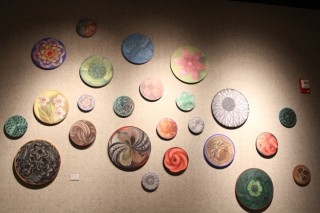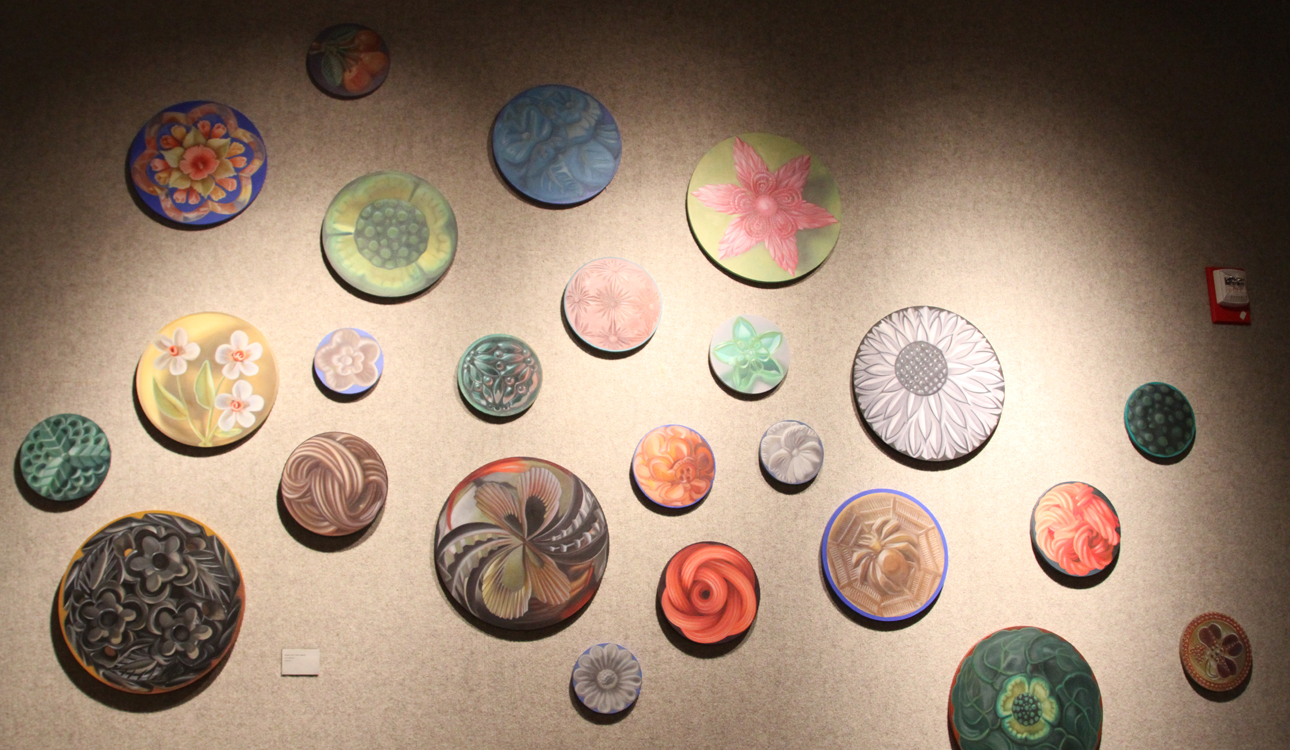
Matthew McCarroll | Lariat Photographer
By Jessica Foreman
Reporter
Every button, brooch and trinket has a story, according to Fort Worth artist Ann Ekstrom. An 18th century button may have been a part of three generations, three different dresses and three individuals’ experiences.
The buttons, trinkets, brooches and pins that are the focus of her paintings are also “little pieces of history,” Ekstrom said.
The Martin Museum of Art is hosting “Conversations, Situations, and Meditations” in Gallery II which features Ekstrom’s large-scale oil paintings of miniature, everyday objects from a different perspective: a personal perspective.
“My show, ‘Conversations, Situations, Meditations’, is a collection of works, in oil and watercolor, that addresses themes of memory and the passage of time,” Ekstrom said. “I have been making paintings of small elderly buttons and pins and bits of ephemera for a long time.”
Ekstrom began collecting funky, plastic jewelry from the ’20s and ’30s in high school when she was able to drive herself to flea markets. She said she loved the hand-made carvings in the pieces; they were a form of folk art. Ekstrom said her mother, the late painter and printmaker Beth Lea Clardy, loved costume jewelry and wearable forms of art.
“It’s what she couldn’t have when she was younger,” Ekstrom said. “So she made it stylish.”
Ekstrom’s collection continued to grow, and eventually the pieces worked their way into her paintings.
“One day in the ’80s I thought, ‘Am I going to be an artist or an art student?’” Ekstrom said. “So I looked around at what interests me, what was in my world.”
Ekstrom’s collection in Martin Museum is a selection of still life works that she has made over the last two decades. In the center of the exhibit is a glass case with a few of Ekstrom’s collection of trinkets.
“A lot of the pieces you can find in her artwork,” said Adriel Greene, educational coordinator for the Martin Museum of Art. “It kind of makes you see that basically you can make art out of anything.”
Greene said Ekstrom’s gallery is an “interactive exhibit,” like a scavenger hunt, because the viewer can look at a painting and then search for the components of that painting in the glass case.
Ekstrom’s “Dresden,” one of her most famous pieces featured in the exhibit, showcases the intricate petal patterns from the lid of a porcelain scent bottle. The 5-foot round canvas has a 3-D effect, which Ekstrom noted was an unintentional element.
She said while “Dresden” was showcased in a gallery, she would watch people go to the side of the painting to check if the canvas was actually projected.
The circular “Dresden” was the first of a series of 100 “tondos” that Ekstrom will paint.
“There are a number of round paintings, from 6 to 60 inches in diameter, called tondos. These represent a single button or object and I call these ‘Meditations.’ Sometimes these are displayed together to represent the contents of a drawer full of secrets.”
Twenty-four tondos are displayed together in her collection. She named the compilation,“Hazzie Lea’s Time Capsule” after her grandmother who had a box full of different trinkets and knick-knacks.
“Most of these things could have been easily thrown away,” Ekstrom said. “Somebody had them in their hand and attached memories.”
Memories are also ingrained in the minds of those who have seen the works of McRay Magleby, the graphic design artist responsible for creating what design professionals from 40 different countries call the “Most Memorable Poster in the World.”
Featured in Gallery I of Martin Museum, the “Wave of Peace” poster commemorates the 40 years of destruction in Hiroshima, Japan, caused by the atomic bomb.
Magleby was one of several professional artists working on a design for the poster; one design was to be chosen. He said while he was beginning to form sketches, a vision of a wave with doves flying from the wave crest came to him in a dream.
Magleby worked on several sketches of a wave, but none of them fit his vision until he came across “The Great Wave off Kanagawa,” an 1829 poster by Japanese artist Katsushika Hokusai. Magleby by said he was moved by the form and design of the wave from Hokusai’s design, and that inspiration formed a basis for his internationally famous “Wave of Peace.”
“The way I think about design is simplified, almost Japanese,” Magleby told City Weekly. “Most people are surprised by the sketches. My style came from falling in love with screen printing while realizing its limitations. You can’t use a lot of details, and the registration has to be simple. But big blocks of color work really well. I’ve tried to work with the limitations of each medium.”
Magleby’s exhibit in Martin Museum features silkscreen posters he has created during his career, including the 2002 Salt Lake City Olympic Games poster and U.S. postage stamps.
As a retired graphic design professor from the University of Utah and the former creative director at Brigham Young University, many of his posters in the Martin exhibit were designed for university-related events.
The poster compositions are bold, clean, and simple, and these factors work together for an eye-catching work of art.
“The same compositional principles apply to any work of art: negative and positive space, breaking up the grid and creating good eye flow,” Magleby said. “I studied Maynard Dixon, who was a great designer; he composed big paintings brilliantly. He leads you off in all different directions, but it always feels right.”
Magleby said he lives his life as an artist would. His house is full of carefully placed compositions, bold colored accent walls and effective use of positive and negative space. Magleby said it is a lifestyle a designer cannot avoid.
Currently, Magleby has turned to painting landscapes in acrylic and lives in Utah.
The Martin Museum, located in the Hooper-Shaefer Fine Arts building, will showcase the exhibits of Ekstrom and Magleby until Oct. 1. These galleries are free to the public, and many pieces are internationally recognized.
“It is the best art department that I personally know of,” Ekstrom said. “It’s really like an artist academy instead of a university art department.”






